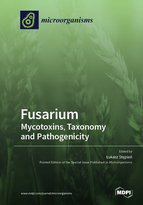Fusarium: Mycotoxins, Taxonomy and Pathogenicity
A special issue of Microorganisms (ISSN 2076-2607). This special issue belongs to the section "Plant Microbe Interactions".
Deadline for manuscript submissions: closed (30 April 2020) | Viewed by 47219
Special Issue Editor
Interests: fungal genetics; Fusarium; molecular biology; mycotoxins; plant pathogens; secondary metabolism
Special Issues, Collections and Topics in MDPI journals
Special Issue Information
Dear Colleagues,
The Special Issue “Fusarium: Mycotoxins, Taxonomy, Pathogenicity” of Microorganisms aims to highlight the most recent reports on all aspects of Fusarium biology. Experts from the fields of plant pathology, genetics, chemistry, toxicology, and molecular biology are invited to contribute their newest findings in the form of full research articles, short communications or focused reviews to increase existing knowledge on this important group of fungi. Many Fusarium species are potent mycotoxin producers, which puts them among of the most devastating and dangerous plant pathogens worldwide. Mycotoxins are not only a threat to the health of mammals, but they often also show phytotoxic and antimicrobial activities. All studies on these aspects are welcome for this Special Issue. The mycotoxin profile is helpful in taxonomic studies, distinguishing sometimes closely related species, but molecular tools are even more powerful in Fusarium species identification and phylogeny, as great diversity of the Fusarium genus forces scientists to continuously revise the previously described taxons. Since evident climatic changes influence the contamination of plant material with Fusarium mycotoxins in new geographical areas and new toxins continuously emerge, reports revealing the chemotype or population changes in various environments are encouraged. Increased availability of sophisticated and advanced methods involving genomic, transcriptomic, proteomic, and metabolomics analyses allows for detailed deciphering of the mechanisms of Fusarium pathogenicity using multiple plant hosts and approaches, accelerating the advances in all fields of Fusarium research.
Dr. Łukasz Stępień
Guest Editor
Manuscript Submission Information
Manuscripts should be submitted online at www.mdpi.com by registering and logging in to this website. Once you are registered, click here to go to the submission form. Manuscripts can be submitted until the deadline. All submissions that pass pre-check are peer-reviewed. Accepted papers will be published continuously in the journal (as soon as accepted) and will be listed together on the special issue website. Research articles, review articles as well as short communications are invited. For planned papers, a title and short abstract (about 100 words) can be sent to the Editorial Office for announcement on this website.
Submitted manuscripts should not have been published previously, nor be under consideration for publication elsewhere (except conference proceedings papers). All manuscripts are thoroughly refereed through a single-blind peer-review process. A guide for authors and other relevant information for submission of manuscripts is available on the Instructions for Authors page. Microorganisms is an international peer-reviewed open access monthly journal published by MDPI.
Please visit the Instructions for Authors page before submitting a manuscript. The Article Processing Charge (APC) for publication in this open access journal is 2700 CHF (Swiss Francs). Submitted papers should be well formatted and use good English. Authors may use MDPI's English editing service prior to publication or during author revisions.
Keywords
- Fusarium species characterization
- mycotoxins in food and feed chains
- chemotype and population changes
- pathogenicity mechanisms







